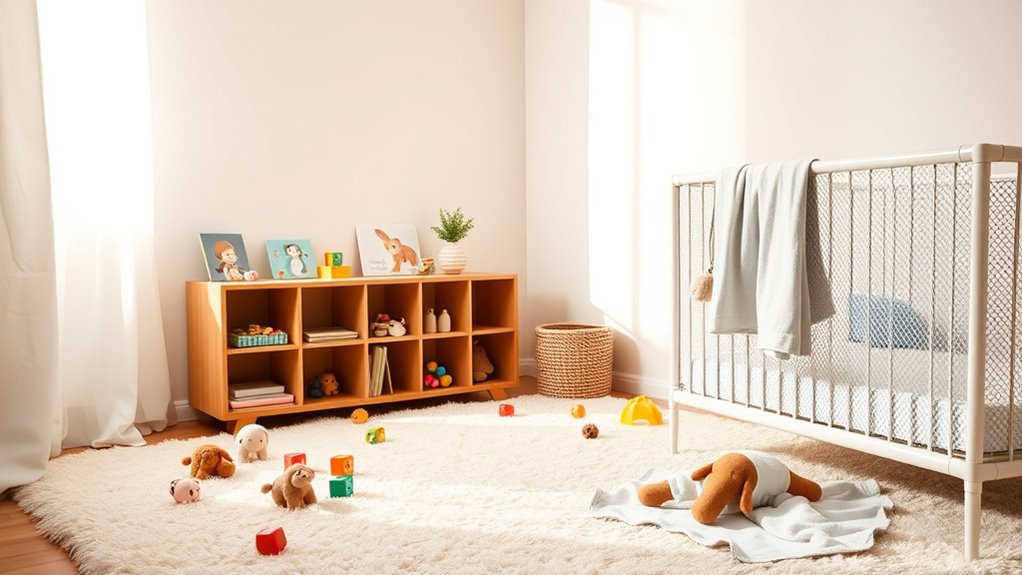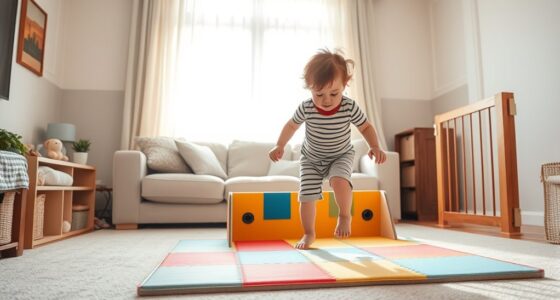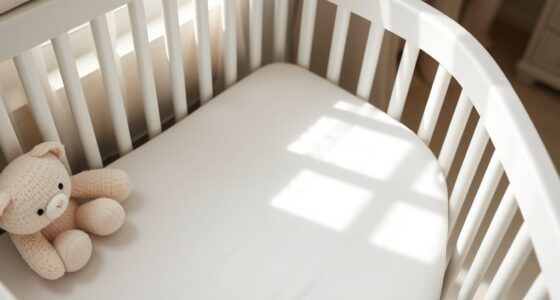Choking hazards are everywhere in your home, from the nursery to the living room. Keep small toys, coins, jewelry, and buttons out of your baby’s reach. Secure cords and strings, and always supervise playtime. Check toys regularly for loose parts, and choose safe, age-appropriate items. Using proper storage and nursery organization minimizes risks. Stay vigilant and proactive—there’s more to discover about spotting hazards throughout your home to keep your baby safe.
Key Takeaways
- Regularly inspect toys, plush items, and household objects for small parts or damage that could pose choking risks.
- Keep small items like coins, jewelry, and buttons out of reach and stored securely to prevent accidental ingestion.
- Secure cords, blinds, and curtain strings to avoid strangulation or choking hazards.
- Organize the nursery with sturdy storage bins and eliminate loose or fallen small objects.
- Supervise playtime diligently and ensure soft bedding and plush toys are age-appropriate and free of loose parts.

Have you ever wondered what common household items could pose a choking risk for your baby? It’s an important question, especially when you’re focused on nursery safety. Babies explore the world with their mouths, so it’s essential to minimize hazards in their environment. Start by carefully selecting toy recommendations that are safe and appropriate for their age. Look for toys labeled as suitable for infants, which are usually made without small parts that can break off or become lodged in their airway. Avoid toys with loose buttons, small batteries, or tiny decorations that could be swallowed. Even plush toys or teething rings should be inspected regularly for wear and tear, as small parts can come loose over time. Creating a safe nursery means removing or securing objects that could accidentally become choking hazards, like loose strings, small decorative items, or plastic bags. When organizing the space, keep small items out of reach and ensure storage bins are sturdy and secure.
In addition to toys, everyday items like coins, jewelry, and buttons can pose risks if they’re accessible to your baby. It’s best to keep these out of reach and, if possible, store them in drawers or containers with child-proof locks. Also, be cautious with stuffed animals and soft bedding; while they’re comforting, they can sometimes obstruct breathing if not used carefully. Regularly check the crib and changing area for small objects or loose parts that might have fallen in. When choosing toys, opt for those that are large enough not to fit entirely in your baby’s mouth—this is one of the most effective toy recommendations for preventing choking. Incorporating professional nursery safety advice can further help you create a secure environment for your child’s development.
In terms of nursery safety, consider the placement of furniture and decor. Avoid hanging items or mobiles with small parts that could fall. Secure cords from blinds or curtains out of reach, as they can be a strangulation or choking hazard. Remember to always supervise your baby during playtime and keep an eye out for anything that could pose a choking risk. By making thoughtful choices about toy recommendations and maintaining a clutter-free, secure environment, you greatly reduce the chances of choking incidents. Preparing the nursery with safety in mind gives you peace of mind, knowing your little one can explore and play without unnecessary risks. Ultimately, staying vigilant and proactive about nursery safety ensures your baby’s environment is as safe as possible for their growth and discovery.
Frequently Asked Questions
How Can I Identify Hidden Choking Hazards in My Home?
To identify hidden hazards and choking risks in your home, you need to do a thorough inspection. Look for small objects, loose cords, and food that could be swallowed. Check furniture, shelves, and toys for parts that might break off. Keep an eye on the floor and surfaces where your baby plays. Regularly review your environment to spot new hazards, ensuring your home stays safe and free of choking risks.
What Are the Signs of Choking in Infants?
Imagine the panic setting in—your baby suddenly struggles to breathe. Signs to watch for include gagging, clawing at the throat, or bluish lips. Your quick reaction matters. Recognize the signs to act swiftly, using rescue techniques like back blows or abdominal thrusts. Knowing these cues can save your baby’s life, turning a terrifying moment into a manageable situation with calm, confident intervention.
Are There Specific Toys That Are Safer for Babies?
You should choose age-appropriate toys that are specifically designed to be choking safe toys for your baby. Look for toys with no small parts that can easily break off and always check the packaging for age recommendations. Avoid toys with loose or removable pieces, and opt for soft, sturdy materials. By selecting safe, age-appropriate toys, you reduce the risk of choking and make sure your baby’s playtime is both fun and safe.
How Often Should I Check My Child’s Environment for Hazards?
Remember, even in the age of dial-up internet, staying vigilant is essential. You should check your child’s environment daily to guarantee home safety and hazard prevention. Regular inspections help spot potential dangers like small objects, sharp edges, or loose cords. Make it a routine, especially during playtime or after any change. This proactive approach keeps your baby safe and helps you catch hazards early, giving you peace of mind.
What Should I Do if My Baby Starts Choking?
If your baby starts choking, stay calm and act quickly. Use CPR techniques like back blows and chest thrusts to dislodge the object. Call emergency services immediately and continue until help arrives. Being prepared with emergency preparedness knowledge is essential, so consider taking a CPR class. Your swift, confident response can save your baby’s life, so practicing these steps regularly is highly recommended.
Conclusion
Remember, your home is like a safe harbor, but tiny treasures and hidden dangers can threaten your baby’s safety. By staying vigilant and removing choking hazards, you’re planting seeds of security that will grow into a sturdy shield. Every careful step you take is like a lighthouse guiding your little one through the stormy seas of curiosity. Keep watch, stay proactive, and let your love be the unwavering anchor in their journey to explore safely.










